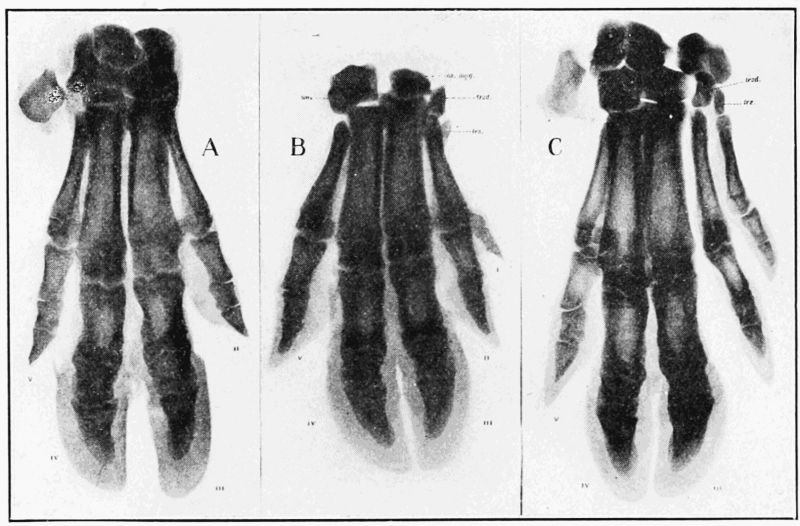File:Prentiss1906 fig04.jpg

Original file (1,618 × 1,064 pixels, file size: 490 KB, MIME type: image/jpeg)
Fig. 4. X-ray photographs of the pig's manus
Showing normal structure and reversionary polydactylism.
A, bones of normal manus;
B, manus in which the pollex is represented by two phalanges and the distal end of the metacarpal bone (I.);
C, manus with pollex completely developed; trz., trapezium.
fig 1 | fig 2 | fig 3 | fig 4 | fig 5 | fig 6
| fig 7
| Historic Disclaimer - information about historic embryology pages |
|---|
| Pages where the terms "Historic" (textbooks, papers, people, recommendations) appear on this site, and sections within pages where this disclaimer appears, indicate that the content and scientific understanding are specific to the time of publication. This means that while some scientific descriptions are still accurate, the terminology and interpretation of the developmental mechanisms reflect the understanding at the time of original publication and those of the preceding periods, these terms, interpretations and recommendations may not reflect our current scientific understanding. (More? Embryology History | Historic Embryology Papers) |
Reference
Prentiss CW. Extra digits and digital reductions. (1906) Popular Science Monthly. 336-448.
Cite this page: Hill, M.A. (2024, April 25) Embryology Prentiss1906 fig04.jpg. Retrieved from https://embryology.med.unsw.edu.au/embryology/index.php/File:Prentiss1906_fig04.jpg
- © Dr Mark Hill 2024, UNSW Embryology ISBN: 978 0 7334 2609 4 - UNSW CRICOS Provider Code No. 00098G
File history
Click on a date/time to view the file as it appeared at that time.
| Date/Time | Thumbnail | Dimensions | User | Comment | |
|---|---|---|---|---|---|
| current | 09:36, 9 April 2019 |  | 1,618 × 1,064 (490 KB) | Z8600021 (talk | contribs) |
You cannot overwrite this file.
File usage
The following page uses this file:
